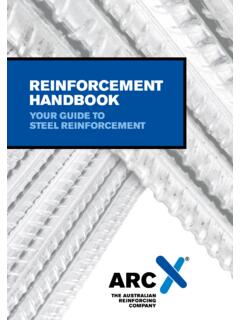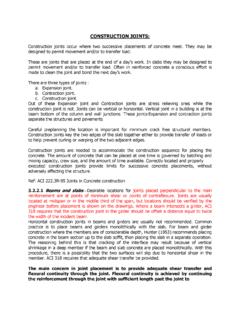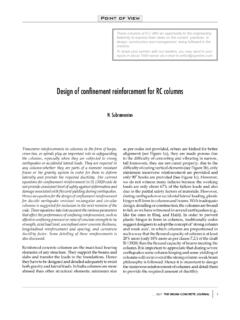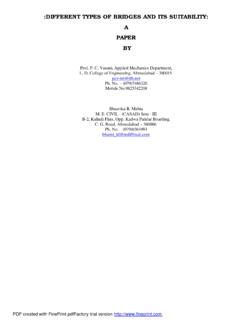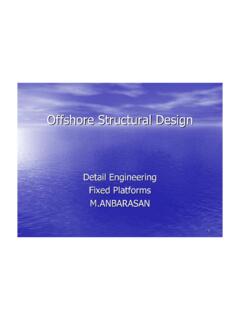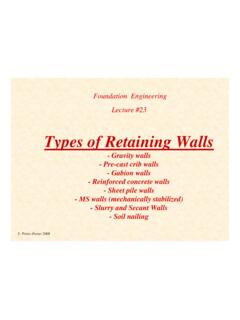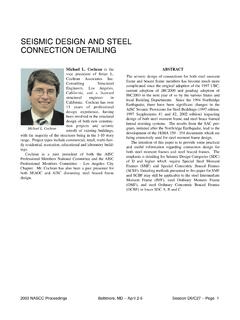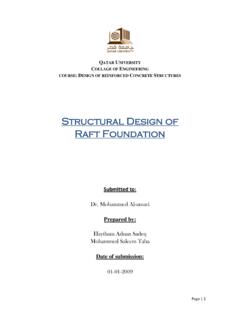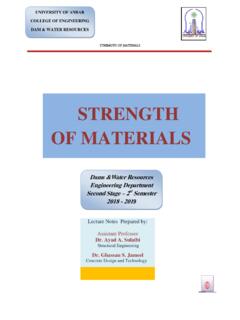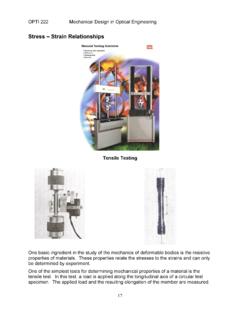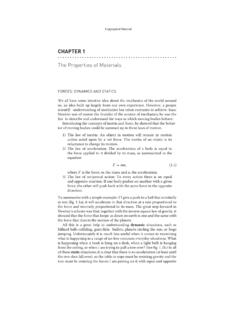Transcription of DUCTILITY REQUIREMENTS FOR BUILDINGS
1 1 DUCTILITY REQUIREMENTS FOR BUILDINGS Prof. P. C. Vasani, Applied Mechanics Department, L. D. College of Engineering, Ahmedabad 380015. Bhumika B. Mehta M. E. CIVIL - (CASAD) Sem - III B-2, Kalindi Flats, Opp. Kadwa Patidar Boarding, C. G. Road, Ahmedabad 380006. Ph. No. (079)6561093 PDF created with FinePrint pdfFactory trial version 2 ABSTRACT At this stage, it is not necessary to explain why study of earthquake resistant structures with DUCTILITY requirement is essential. After the killing earthquake of Bhuj on January 26, 2001, the attitude of the structural engineers of looking towards the earthquakes has totally changed. In general, the analysis of earthquake forces and design of earthquake resistant structure is very much complex in nature.
2 Of course, there exist some simplifying assumptions and thoughts, which make this complex problem somewhat simple to handle. It is to be noted that the actual practice of carrying out earthquake resistant construction varies from country to country and from time to time. The essentiality and provisions of the DUCTILITY of the engineering structure is discussed here. If ductile members are used to form a structure, the structure can undergo large deformations before failure. This is beneficial to the users of the structures, as in case of overloading, if the structure is to collapse, it will undergo large deformations before failure and thus provides warning to the occupants. This gives a notice to the occupants and provides sufficient time for taking preventive measures.
3 This will reduce loss of life. DUCTILITY DUCTILITY can be defined as the ability of material to undergo large deformations without rupture before failure . The DUCTILITY is increased by, An increase in compression steel content. An increase in concrete compressive strength. An increase in ultimate concrete strain. And is decreased by, An increase in tension steel content. An increase in steel yield strength. An increase in axial load. Significance of DUCTILITY DUCTILITY gives a notice to the occupants and provides sufficient time for taking preventive measures. This will reduce loss of life. Comparison with brittle material In the case of reinforced concrete members subjected to inelastic deformation, not only strength but also DUCTILITY plays vital role in the design.
4 A ductile material is the one that can undergo large strains while resisting loads. Necessity of ductile detailing Ductile detailing is provided in structures so as to give them adequate toughness and DUCTILITY to resist severe earthquake shocks without collapse. DUCTILITY criteria for earthquake resistant structures The performance criteria is given in earthquake code Variables affecting the DUCTILITY Design for DUCTILITY Ductile detailing for flexure members Sources References PDF created with FinePrint pdfFactory trial version 3 CONTENTS DUCTILITY REQUIREMENTS for building DUCTILITY Significance of DUCTILITY Comparison with brittle material Necessity of ductile detailing DUCTILITY criteria for earthquake resistant structures Variables affecting the DUCTILITY Design for DUCTILITY Ductile detailing for flexure members Sources References PDF created with FinePrint pdfFactory trial version 4 v DUCTILITY REQUIREMENTS for building DUCTILITY
5 DUCTILITY can be defined as the ability of material to undergo large deformations without rupture before failure . DUCTILITY in concrete is defined by the percentage of steel reinforcement with in it. Mild steel is an example of a ductile material that can be bent and twisted without rupture. Member or structural DUCTILITY is also defined as the ratio of absolute maximum deformation to the corresponding yield. This can be defined with respect to strains, rotations, curvature or deflections. Strain based DUCTILITY definition depends almost on the material, while rotation or curvature based DUCTILITY definition also includes the effect of shape and size of the cross-sections. Each design code recognizes the importance of DUCTILITY in design because if a structure is ductile it ability to absorb energy without critical failure increases.
6 DUCTILITY behavior allows a structure to undergo large plastic deformations with little decrease in strength. In general the DUCTILITY is increased by, An increase in compression steel content. An increase in concrete compressive strength. An increase in ultimate concrete strain. And is decreased by, An increase in tension steel content. An increase in steel yield strength. An increase in axial load. SIGNIFICANCE OF DUCTILITY If ductile members are used to form a structure, the structure can undergo large deformations before failure. This is beneficial to the users of the structures, as in case of overloading, if the structure is to collapse, it will undergo large deformations before failure and thus provides warning to the occupants.
7 This gives a notice to the occupants and provides sufficient time for taking preventive measures. This will reduce loss of life. Structures are subjected to unexpected overloads, load reversals, impact and structural movements due to foundation settlement and volume changes. These items are generally ignored in the analysis and design. If a structure is ductile than taken care by the presence of some DUCTILITY in the structure. The limit state design procedure assumes that all the critical sections in the structure will reach their maximum capacities at design load for the structure. For this to occur, all joints and splices must be able to withstand forces and deformations corresponding to yielding of the reinforcement. COMPARISON WITH BRITTLE MATERIAL Brittleness is a property of material that will fail suddenly without undergoing noticeable deformations.
8 Brittle structures do not give notice before failure and may collapse and the occupants may not have time to take measures to prevent collapse. concrete is an example of brittle material. To avoid failure of structure the structural engineer must take all provisions to increase the DUCTILITY of structure. The structural engineer should design a structure functioning as a ductile one. By suitably anchoring the reinforcement, the DUCTILITY of a structure can be increased to a greater extent with little increase in cost. PDF created with FinePrint pdfFactory trial version 5 Reinforced concrete structures, unlike steel structures, tend to fracture or fail in a relatively brittle fashion as the DUCTILITY or deformation capacity of conventional concrete is limited.
9 In such structures the brittle failure as result of inelastic deformation can be avoided only if the concrete is made to behave in a ductile manner so that the member can absorb and dissipate large amount of energy. Hence in the case of reinforced concrete members subjected to inelastic deformation, not only strength but also DUCTILITY plays vital role in the design. A ductile material is the one that can undergo large strains while resisting loads. Graph shown below also show comparison between brittle and ductile material regarding to deformation. BRITTLE AND DUCTILE FORCE-DEFORMATION BEHAVIOUR NECESSITY OF DUCTILE DETAILING Ductile detailing is provided in structures so as to give them adequate toughness and DUCTILITY to resist severe earthquake shocks without collapse.
10 Ductile detailing is provided for the following structures. The structures is located in seismic zone IV and V. The structure is located in seismic zone III and has the important factor (I) greater than 1. The structure is located in seismic zone III and is an industrial structure. The structure is located in seismic zone III and is more than 5 storeys high. DUCTILITY CRITERIA FOR EARTHQUAKE RESISTANT STRUCTURES The performance criteria in most earthquake code provisions require that a structure be able to : Resist earthquakes of minor intensity without damage. A structure would be expected to resist such frequent but minor shocks within its elastic range of stresses. Resist moderate earthquakes with minor structural and some non-structural damage.
